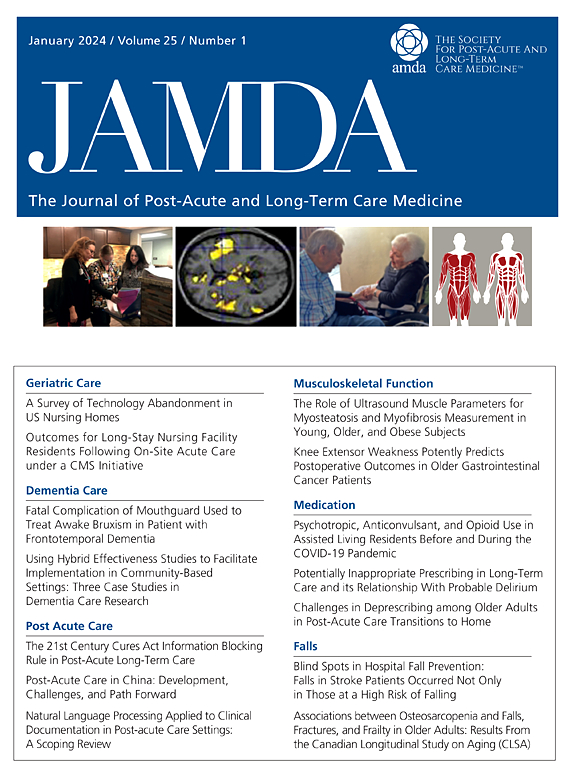Clinical Predictors of Mortality in People with Severe Behavioral and Psychological Symptoms of Dementia
IF 4.2
2区 医学
Q2 GERIATRICS & GERONTOLOGY
Journal of the American Medical Directors Association
Pub Date : 2025-02-01
DOI:10.1016/j.jamda.2024.105374
引用次数: 0
Abstract
Objectives
Dementia significantly impacts quality of life, health care costs, and caregiver burden, being a leading cause of death among older adults. We investigated predictors of mortality in people with severe behavioral and psychological symptoms of dementia (BPSD).
Design
A multicentric longitudinal observational study was conducted, comprising clinical assessments at baseline and every 6 months for 3 years.
Setting and Participants
People with severe BPSD (Neuropsychiatric Inventory, NPI ≥32) living at home.
Methods
Data on demographics and clinical characteristics were collected at baseline and during 6-monthly follow-ups over 3 years. The main outcome was mortality, documented over a total period of 4 years and analyzed using the Cox proportional hazards model.
Results
Of the 508 patients with dementia with severe BPSD, 165 (32.5%) died during the 4-year follow-up. Non-survivors were older (79.8 ± 7.7 vs 77.3 ± 8.0; P < .001), more likely to be male (58.8% vs 38.5%; P < .001), and had higher BPSD severity (NPI: 57.2 ± 20.2 vs 50.3 ± 17.9; P < .001), lower cognitive function according to the Mini-Mental State Examination (MMSE) (13.5 ± 6.6 vs 16.4 ± 5.9; P < .001), and worse functional status according to the Alzheimer's Disease Cooperative Study – Activities of Daily Living Scale (ADCS) (28.8 ± 16.4 vs 36.3 ± 17.2; P < .001) at baseline. Significant predictors of mortality included male sex [hazard ratio (HR), 2.03; 95% confidence interval (95% CI), 1.46–2.82; P < .001], older age at diagnosis (HR, 1.05; 95% CI, 1.03–1.07; P < .001), higher NPI scores (HR, 1.01; 95% CI, 1.01–1.02; P = .002), lower MMSE (HR, 0.95; 95% CI, 0.93–0.98; P = .001), lower ADCS (HR, 0.98; 95% CI, 0.98–0.99; P = .015), and lower quality of life rated by proxy (HR, 0.97; 95% CI, 0.95–0.99; P = .021). The use of antidepressants (HR, 0.69; 95% CI, 0.48–0.98; P = .038) was associated with increased survival. Delusions (HR, 1.0; 95% CI, 1.03–1.12; P < .001), hallucinations (HR, 1.07; 95% CI, 1.02–1.11; P = .002), and agitation/aggression (HR, 1.05; 95% CI, 1.01–1.09; P = .021) were significantly linked to increased mortality.
Conclusions and Implications
Older age, male sex, severe BPSD, and lower cognitive and quality of life scores significantly predict increased mortality in patients with severe BPSD.
伴有严重行为和心理症状的痴呆患者死亡率的临床预测因素
目的:痴呆症显著影响生活质量、医疗保健费用和照顾者负担,是老年人死亡的主要原因。我们研究了严重行为和心理痴呆症状(BPSD)患者的死亡率预测因素。设计:进行了一项多中心纵向观察研究,包括基线和每6个月的临床评估,持续3年。环境和参与者:重度BPSD患者(神经精神量表,NPI≥32)。方法:在基线和6个月的3年随访期间收集人口统计学和临床特征数据。主要结果是死亡率,记录了4年的总时间,并使用Cox比例风险模型进行分析。结果:508例痴呆合并重度BPSD患者中,165例(32.5%)在4年随访期间死亡。非幸存者年龄较大(79.8±7.7 vs 77.3±8.0;P < 0.001),男性更有可能(58.8% vs 38.5%;P < 0.001),且BPSD严重程度较高(NPI: 57.2±20.2 vs 50.3±17.9;P < 0.001),简易精神状态检查(MMSE)认知功能降低(13.5±6.6 vs 16.4±5.9;P < 0.001),根据阿尔茨海默病合作研究-日常生活活动量表(ADCS),功能状态更差(28.8±16.4 vs 36.3±17.2;P < 0.001)。死亡率的重要预测因素包括男性性别(危险比[HR], 2.03;95%置信区间[95% CI], 1.46-2.82;P < 0.001),诊断年龄较大(HR, 1.05;95% ci, 1.03-1.07;P < 0.001), NPI评分越高(HR, 1.01;95% ci, 1.01-1.02;P = .002), MMSE较低(HR, 0.95;95% ci, 0.93-0.98;P = .001),较低的ADCS (HR, 0.98;95% ci, 0.98-0.99;P = 0.015),而代理评价的生活质量较低(HR, 0.97;95% ci, 0.95-0.99;P = .021)。抗抑郁药的使用(HR, 0.69;95% ci, 0.48-0.98;P = 0.038)与生存率增加相关。妄想(HR, 1.0;95% ci, 1.03-1.12;P < 0.001),幻觉(HR, 1.07;95% ci, 1.02-1.11;P = .002),激越/攻击性(HR, 1.05;95% ci, 1.01-1.09;P = 0.021)与死亡率增加显著相关。结论和意义:年龄较大、男性、重度BPSD和较低的认知和生活质量评分显著预测重度BPSD患者死亡率增加。
本文章由计算机程序翻译,如有差异,请以英文原文为准。
求助全文
约1分钟内获得全文
求助全文
来源期刊
CiteScore
11.10
自引率
6.60%
发文量
472
审稿时长
44 days
期刊介绍:
JAMDA, the official journal of AMDA - The Society for Post-Acute and Long-Term Care Medicine, is a leading peer-reviewed publication that offers practical information and research geared towards healthcare professionals in the post-acute and long-term care fields. It is also a valuable resource for policy-makers, organizational leaders, educators, and advocates.
The journal provides essential information for various healthcare professionals such as medical directors, attending physicians, nurses, consultant pharmacists, geriatric psychiatrists, nurse practitioners, physician assistants, physical and occupational therapists, social workers, and others involved in providing, overseeing, and promoting quality

 求助内容:
求助内容: 应助结果提醒方式:
应助结果提醒方式:


